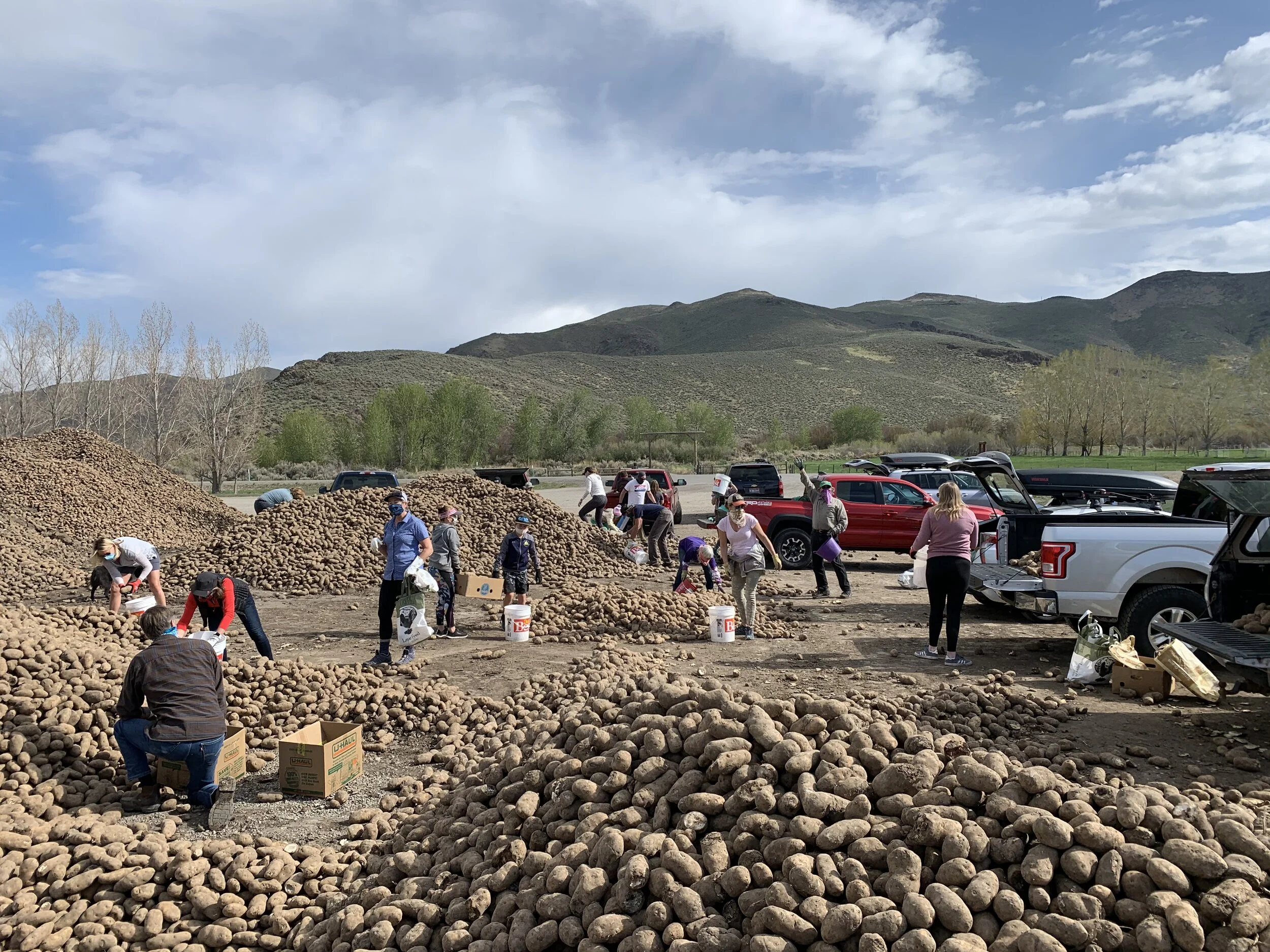The following summary was developed from a virtual peer-learning exchange hosted by and for the Northern Blues All Lands Partnership, and organized by Rural Voices for Conservation Coalition (RVCC), Wallowa Resources, the Umatilla and the Wallowa-Whitman National Forests.
Rural Partnership Program: An opportunity for community-driven development
Governance Structures for Partners Working Across Large Landscapes: Key Takeaways
The following summary was developed from two peer-learning sessions organized by Rural Voices for Conservation Coalition and Oregon State University Extension/the Ecosystem Workforce Program. The sessions in January and March, 2021, were attended by members of four landscape-scale, restoration-focused partnerships operating in northern Colorado, northern Arizona, southern Oregon and northeastern Oregon. These takeaways reflect our discussions about how to create and improve governance documents and structures to better support partners working together across large areas, particularly in considering potential or current CFLRP awards.
Participating partnerships:
Four Forests Restoration Initiative (AZ)
Front Range Roundtable (CO)
Northern Blues (OR)
Southern Oregon Forest Restoration Collaborative/Rogue Forest Partners (OR)
→ Determine the scale, scope and desired outcomes of the partnership’s work. Several partnerships found it helpful to develop an overarching framing strategy that helped guide their restoration work. This type of strategy, and the process of creating it, helped partners collectively define a vision for what they hoped to do and achieve across a landscape, draw on relevant science/information, and set a scope of work and general sideboards. Attendees said this type of document can also be useful for guiding prioritization of work in a transparent way and can inform public lands planning processes.
→ Know why you’re working together. Partners said it was important to clearly define the purpose of the partnership (e.g. peer learning, landscape prioritization, coordination, networking, political advocacy) and how it compliments, supports and interacts with other more localized or project-specific groups and activities.
→ Create multi-scalar structures. Each of the partnerships structured themselves with several interacting tiers and configurations of groups and people to connect more localized community-based or project-level work with landscape-level planning and coordination. In addition to large stakeholder groups for example, many collaboratives had some sort of executive committee or overall leadership team, and multiple topical or resource-focused working groups. They also incorporated or interacted closely with more localized project-focused groups or efforts.
Northern Blues structure: place-based groups tied to a certain project and geography; multi-partner “resource teams” focused on themes like private landowner motilization, monitoring, and communication; all-lands leadership team; and a larger stakeholder group associated with the Northern Blue Mountain Cohesive Strategy Partnership.
Front Range Roundtable structure: multiple place-based and/or issue-focused collaboratives/working groups; sub-groups of the FRRT collaborative focused on community protection and landscape restoration; FRRT executive team; and a larger stakeholder group.
4FRI structure: 4FRI topical working groups (focused on stakeholder engagement, final EIS, industry/biomass, multiparty monitoring, and comprehensive implementation); 4FRI steering committee; and a larger stakeholder group.
Southern Oregon structure: multiple community and valley-focused collaborative and partnership efforts; basin-wide implementation-focused partnership (Rogue Forest Partners); nonprofit entity (Southern Oregon Forest Restoration Collaborative) that represents a broad cross-section of interests across the Rogue River basin and works strategically across the basin to facilitate the Rogue Forest Partners and support strategic planning, zones of agreement, and collaboration.
→ Create some structure for how partners work together. Partnerships found value in establishing principles and standards for how the partners work together and make decisions (e.g., how communication happens, what engagement looks like, what mutual learning should occur, how to reach decisions or some level of agreement).
→ Define roles and responsibilities of partners. Some partnerships created specific documents detailing partner roles and responsibilities as they related to accomplishing specific tasks. Others used charter documents to outline more general roles and responsibilities for partners (e.g., communicate with the USFS, mentor new members, deliver recommendations, actively participate). Some people emphasized the importance of defining partner roles and responsibilities in such a way that partners can have different and evolving roles with various groups and projects while maintaining involvement in the partnership.
→ Document partners’ commitment. Partnerships emphasized the need to establish expectations for partners related to joining and continuing involvement in the partnership. Making those commitments clear can help maintain consistent engagement even as representatives from each partner organization cycle in and out.
Other takeaways...
→ Importance of adaptability and responsiveness. Partnerships recommended regularly revisiting and being willing to change partner roles and responsibilities, the purpose of the partnership, partnership focus, or structure. Questions to ask to prompt a reevaluation might include: are some working groups no longer relevant? Are the structures for working together no longer applicable to current scope or focus of work? Does the partnership look different with or without certain funding sources or programs like CFLRP? Partnerships have used surveys to evaluate the state of the partnership’s work.
→ Importance of intentional prioritization, planning, evaluation by the larger partnership to avoid random acts of restoration and competition among partners. This prioritization also has to navigate between the need to take advantage of opportunities (funding, shelf NEPA etc.) and being more intentional with design and prioritization.
One strategy is to map past, current, and planned restoration or wildfire mitigation activities across the entire area of the partnership’s work. This can reveal how or if the partnership’s work is achieving desired outcomes at the necessary scale and can also be useful to identify gaps in restoration across the landscape.
Strategic plans can also be useful for transparent and intentional prioritization.
→ Importance of documentation. Recording partner roles, commitment, standards for working together, and decision-making can be especially helpful if partners are operating in a low-trust environment. Documentation is also important to help maintain consistency through turnover.
Potato Rescue Project Helps Feed Rural Communities in Idaho
By Jessica Sabine Brothers
With agriculture accounting for nearly 17 percent of employment in rural and remote areas, the agricultural industry has taken a major hit due to the disrupted markets and supply chains that resulted from the Coronavirus crisis and shutdown. This month in Hailey, Idaho, community advocate Molly Page was inspired to reconnect a disrupted potato supply chain in her county through a grassroots rescue mission. Molly organized a group of over 50 volunteers to get 40,000 lbs of fresh, local produce in the hands of her community members over the course of two weekends. This grassroots effort has made a huge impact in Blaine County, where half of the area students receive free and reduced lunches. Her efforts have since expanded to neighboring counties of Camas, Gooding and Lincoln.
We were able to follow up with Molly, who is married to Tom Page, an active RVCC participant, to learn more about her community efforts:
RVCC: When you heard about the potatoes being discarded in Blaine County, what led you to reach out to the grower? Did you already have a connection with the farm owner?
Molly: On the first weekend that we organized a ‘potato rescue’, we did not have a connection with the grower. They were simply leaving the potatoes out in big piles for the public to come and get. The grower (and their potatoes) are in Picabo, Idaho. Most of the population in our county is 20 to 45 minutes away from there. Picabo is not on a typical route that people travel in the county, so many people don’t know where it was or how to get there. With our local food bank having distributed as much food in the first month of the pandemic than it did all of last year, I thought we should connect the dots, getting discarded produce to the people who needed it during this time.
Since many people in our county know each other, I was easily able to connect with the grower (Silver Creek Seed - Mark and Jill Johnson) after that first weekend. Now, we are in regular contact when communities want potatoes. Mark and Jill have been gracious and generous with their time and potatoes.
Volunteers loading trucks of potatoes. Photo by Molly Page
RVCC: What actions led to such an engaged community presence in this effort?
Molly: I’ve been doing community organizing in the area for a few years, so people are used to me asking for them to show up and help with things. The network we have built really allowed us to mobilize quickly. I put out a call on social media for volunteers on Friday afternoon, and within 24 hours, we had people showing up and loading potatoes in their trucks to take north to communities in need. Living in a small community also paid off in that I know the mayors and many city council members in the three towns where we dropped potatoes. I had approval from the cities to leave the potato piles within an hour of asking.
RVCC: What are the biggest COVID-19 impacts you’ve seen play out in Hailey? Are there some silver lining activities or grassroots efforts that you’ve seen pop up during this time?
Molly: Blaine County is the home to Sun Valley ski resort. With so many visitors from around the country, we actually had the highest per capita rate of COVID-19 in March. Neighbors, friends and family were all sick. Our county was the first in the state to close everything down on March 15th. We are slowly opening back up, but it has been really damaging to our local economy. Our community was crushed by COVID-19, so everyone is very cautious about getting life back to normal.
If I were to name a silver lining—it’s been great to see our community rally and support each other. From people making and giving away masks to helping deliver for the local CSA to supporting local businesses and nonprofits.
The coronavirus has shown us that there are vulnerabilities in our food system, but the silver lining is that we have a strong local agricultural community that can fill a big gap that has been exposed. Our local CSA has more than tripled their business since the pandemic started. My family has been getting weekly deliveries from them for two years, but we are ordering more produce, milk, eggs and locally-grown and milled flour. My daughter is now making sourdough bread for our neighbors!
RVCC: What’s one thing you’d share with others who are interested in getting more engaged in their community during COVID-19?
Molly: Show up and help when you’re asked! If there isn’t anyone asking and you see something needs to be done, find a few friends and do it! I’ve built incredible friendships in the three years that I’ve done community organizing. It’s been very rewarding.
Delivering potatoes in Dietrich, Idaho. Photo by Molly Page
Molly is a board member of Conservation Voters for Idaho. She enjoys navigating the intersection of politics and conservation. She loves door knocking for candidates and issues in her community.
Molly’s husband Tom has been an active participant and supporter in RVCC. Tom and Molly’s Big Creek Ranch in Idaho consists of a complex mosaic of parcels. Most of their ranch conservation efforts to date have been focused on improving irrigation practices and infrastructure. The ranch is also unique in that all cattle belong to other operators, although the grazing rotations and feeding are performed by Big Creek Ranch staff. To learn more about Big Creek Ranches, visit their website.
You can read more about Molly’s potato rescue efforts in her local MT Express newspaper, as well as national coverage in TIME.





